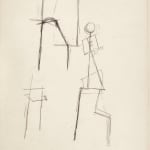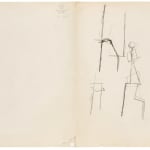













Pablo Picasso
Silhouette, 1912
pencil on paper
34.1 x 22.2 cm
framed 49.5 x 37.5 cm
framed 49.5 x 37.5 cm
Copyright The Artist
Further images
-
(View a larger image of thumbnail 1
)

-
(View a larger image of thumbnail 2
)

-
(View a larger image of thumbnail 3
)

-
(View a larger image of thumbnail 4
)

-
(View a larger image of thumbnail 5
)

-
(View a larger image of thumbnail 6
)

-
(View a larger image of thumbnail 7
)

-
(View a larger image of thumbnail 8
)

-
(View a larger image of thumbnail 9
)

-
(View a larger image of thumbnail 10
)

-
(View a larger image of thumbnail 11
)

-
(View a larger image of thumbnail 12
)

-
(View a larger image of thumbnail 13
)

-
(View a larger image of thumbnail 14
)

Provenance
Claude Picasso has confirmed the authenticity of this work. Accompanied by a certificate of authenticity and included in the Picasso EstateEstate of the artist
Marina Picasso, the artist’s granddaughter
Literature
Text concerning a different work from the same year and subjectPablo Picasso (1881-1973)
Femme à la guitare, pen and ink on paper 17.1 x 12.4 cm. 1912
When exhibited in 1940 at the Museum of Modern Art, Femme à la guitare was hung alongside eleven other Cubist works on paper by Picasso, displayed as one group. Though distinctly individual, as a series they showed the artist’s working practice through variations on a theme, moving around, through and into his subject, interrogating it with the utmost curiosity. Some display bare outlines, some with highlights of shading, some with several figures or text included. Femme à la guitare, within this group, is a distinctively resolved composition with great technical variety seen through the alternating tempo of its line and a succinctness to the dynamic articulation of its subject.
Femme à la Guitare was drawn in 1912, a pivotal year in both Picasso's career and in his personal life. Picasso's art was undergoing a transformation whereby the analytic cubist style of the past years was evolving into synthetic cubism. As John Richardson explains, 'Analytic cubism permitted the two artists to take things apart: dissect them "with the practiced and methodical hand of a great surgeon" (as Apollinaire said of Picasso)... Synthetic cubism, on the other hand, permitted Picasso and Braque to put things together again, to create images and objects in a revolutionary new way, out of whatever materials they chose' (in A Life of Picasso, 1907-1917: The Painter of Modern Life, London, 1996, vol. 1, p. 106).
The guitar motif provided Picasso with an interesting range of lines, forms and volumes and served as a fertile ground for his cubist investigations. It also had a curvaceous quality that the artist equated with femininity, providing a contrast of line with the angular, planar dissection of other subjects. Picasso had long held a fascination with the instrument, and in 1912 he would create an enormous sheet-metal sculpture in its honour. As Joseph Palau I Fabre observes: 'The year 1912 is without doubt, after 1907, the most significant in the history of modern art so far. Its debut, for want of a better term, was marked by Picasso’s famous El Guitarrot…' (J Palau i Fabre, Picasso Cubism, New York, 1990, p. 240)
Picasso would continue to deconstruct the guitar almost obsessively throughout 1912. In Femme à la Guitare, we see just a small hint as to the guitar’s presence, referred to in the swirling line at the lower edge with strings extending upward, a sound hole to the centre and tiny fingers suggested towards the right grasping the fretboard. Reminiscent of the painting Ma jolie (Zervos, vol. II*, no. 244) which was painted over the Winter of 1911-1912 and exhibited in the same exhibition at the Museum of Modern Art, New York, in 1940, the figure absorbs the predominance of space, the words ‘MA JOLIE’ inscribed at the lower edge referring to his new love at that time Marcelle Humbert (also known as Eva Gouel). The guitar that serves as the punctum to enliven this composition, introducing a new movement, a point of contrast with his sitter.